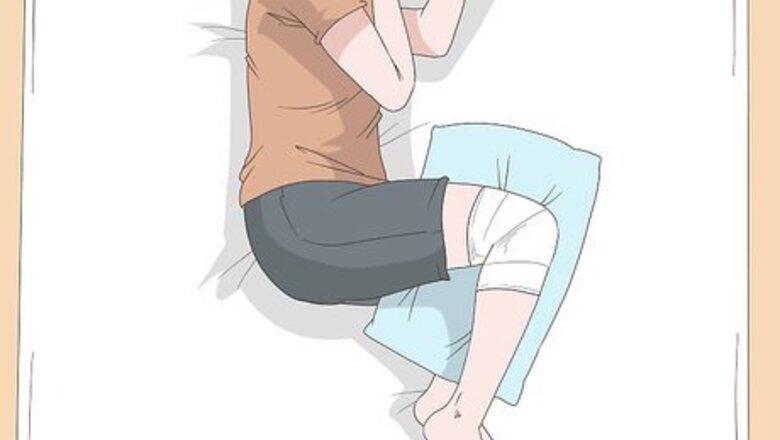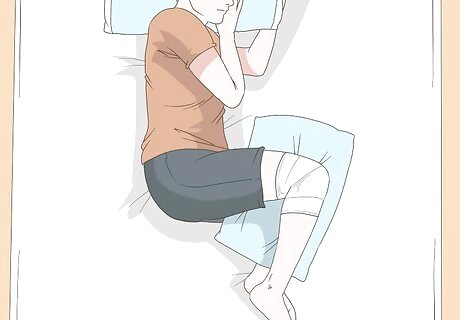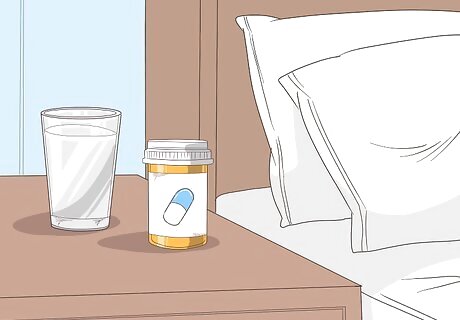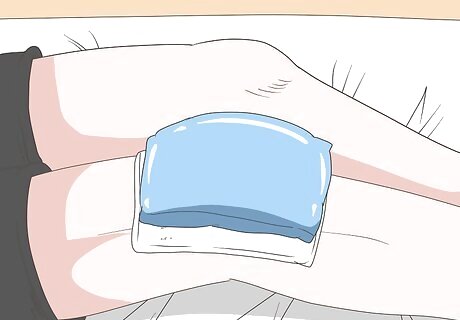
views
Finding the Right Position
Sleep on your back with a pillow under your knee and calf. Right after your surgery, it’s best to only sleep on your back. Your leg should stay as straight as possible with proper support to avoid hyperextension of your knee to keep blood flowing to your surgery site. When you sleep on your back, place a pillow lengthwise under your knee and calf. This keeps your leg straight and cushions your knee from pressure. Use a second pillow if the first one is too flat. It isn’t harmful to place the pillow directly under your foot, but this puts stress on your knee and will probably be painful. Placing the pillow under your knee and calf distributes the weight better.
Pile pillows under your legs if you sleep with a foam wedge and pillows. Doctors sometimes suggest a foam wedge for surgery patients to place under their legs. It's designed to elevate your legs while you sleep on your back. If you use one, pile 1 or 2 more pillows on top of the wedge to keep your leg straight. The wedge by itself keeps your knee bent, which is bad for your recovery. This is a better position for a short rest or nap rather than sleeping all night. Even if it’s comfortable, you’ll probably shift at some point during the night and your leg could fall off this pile.

Sleep with a pillow between your legs if you sleep on your side. If sleeping on your side if more comfortable for you, lie on your non-operative side. Then, place a pillow between your legs to cushion your knee. If you need more support, add a second pillow to pad your knee and make your leg comfortable. Sleeping on your side may not be the most comfortable position after your surgery because it may be too painful. It also doesn’t keep your leg straight enough. You should have less pain and it’s not as important to keep your knee straight. It’s safer to sleep on your side at this point. Remember to only sleep on your non-operative side if you do sleep on your side. Sleeping on your operative side puts a lot of pressure on your surgery site and will probably be painful.Warning: If you sleep on your side, don't wiggle or move around too much in bed. This can trigger pain or slow down the healing process in your knee.
Avoid sleeping on your stomach or operative side. Unfortunately, if you prefer sleeping on your stomach, this won’t be possible while you recover. Laying on your stomach places pressure directly on your surgery site and will be too painful to fall asleep. The same is true for sleeping on your operative side. Stick with sleeping on your back or non-operative side for the duration of your recovery. The major recovery time after a knee replacement is 3 to 6 weeks, although it may take several months to heal entirely. After 3 weeks, you can start resuming most of your daily activities if you can walk well enough. You can also begin sleeping normally again, as long as certain sleeping positions don't cause you any pain.
Managing Pain with Medication
Take your pain medication 1 hour before bed. After your surgery, you'll be prescribed medication to help you manage the pain. Most prescription painkillers direct you to take 1 every 4 to 6 hours. Schedule your doses throughout the day so your last dose falls 1 hour before your bedtime. If you take your medication right before bed, you’ll still feel pain until it takes effect. This will make falling asleep difficult. Taking your medication 1 hour before bedtime gives it time to work, which means you can get into bed without any pain. If you have trouble remembering to take your medication, try setting an alarm to go off for each of your scheduled doses as a reminder.

Leave another dose of medicine next to your bed if you wake up in pain. Most pain medications last for 4 to 6 hours. This means 1 dose may not last through the whole night. Prepare for this possibility by leaving another dose next to your bed with a glass of water. Then if you wake up in pain, it’s easy to take more medication and get back to sleep. Only leave one dosage near your bed, not the whole bottle. If you’re groggy, you could accidentally take more than you’re supposed to if you leave the whole bottle next to you. Double check with the directions on your pain medication. If it says to only take 1 every 8 hours, then don’t leave another near your bed.
Consult your doctor before taking sleep aids. If you still can’t sleep through the night after trying different techniques, you may be tempted to try taking sleep aids. Never do this without consulting your doctor first. Sleep aids may interact with painkillers and cause adverse health effects. Do not mix them with your painkillers unless your doctor says this is safe. Your doctor may recommend a sleep aid that doesn’t interact with the pain medication you’re on. They may also change your pain prescription to one with less side effects.
Developing Better Sleeping Habits

Ice your knee for 15-20 minutes right before bed to dull your pain. While you're in recovery, icing your knee can help it feel numb so that it doesn't hurt. Drape a towel over your knee to protect your skin. Then, apply an ice pack to your knee for 15-20 minutes right before bed. Don't fall asleep with the ice pack on your knee. If you do, it may damage your skin.
Make sure your room is dark and cool. It's easier to fall asleep in a dark room, as light can wake you up. Additionally, cooler temperatures may help you go to sleep easier, with 60 to 67 °F (16 to 19 °C) being the ideal. Use curtains to block out the light from your windows, and remove any items that generate light. Additionally, turn down your air conditioner or use a fan to cool off. Pick pajamas and bedding that allow you to stay comfortable without getting too warm. Choose a temperature that feels most comfortable for you.
Avoid taking naps throughout the day. If you haven’t been sleeping well, taking a midday nap probably sounds great. Unfortunately, this can mess up your sleeping schedule even worse. You’ll be less tired at bedtime and falling asleep will take longer. Avoid the temptation to take a nap. Go to bed earlier instead. If you can’t help it and need to take a nap, limit your sleeping time. Set an alarm for an hour so you won’t oversleep.
Take a few days off from physical activity if you’ve been in pain. While physical activity is important for your recovery, you may be overdoing it. If you’ve been in recovery for several weeks and are still experiencing bad pain when trying to sleep, you could be pushing your knee too hard. Try taking a few days off from physical therapy or other activities you were doing. This helps your injury heal and could help your nighttime pain. Communicate with your physical therapist if you feel too much pain. Physical therapy should push your body, but it shouldn’t cause damage. Your therapist can adjust the routine if you’re experiencing lasting pain.
Wind down before bed. Relaxing yourself before bedtime is especially important if you’ve been having trouble sleeping. Develop an effective bedtime routine by eliminating stimulating activities and calming yourself. This slows your mind down and signals to your brain that it’s time to sleep. Stop looking at your phone, computer, and TV. Bright lights from electronic devices stimulate your brain and make it harder to fall asleep. Instead, try a more relaxing activity like reading. Listening to soft music, doing aromatherapy, or meditating are all good activities to get relaxed for bedtime. Be consistent with your bedtime routine. If you do the same activities every night, you start training your brain this it’s time to sleep when you start this routine.
Do a relaxing activity if you can’t sleep within 30 minutes. If 30 minutes have gone by and you can’t get to sleep, don’t just lie in bed. Turn a light on and try doing a quiet activity to get your mind in a more relaxed state. Reading or knitting are easy activities to do in bed that help you relax. Do not look at your phone or turn the TV on. These activities stimulate your brain further and make it harder to sleep. This advice usually says that you should get out of bed and go to another room to do your activity. If you’re recovering from surgery, however, this may not be possible. Turning on a lamp and reading in bed will work as well.
Don't use stimulants after noon if you use them at all. Stimulants like coffee, soda, or caffeinated tea may keep you awake at night. It's okay to have a cup of coffee or tea in the morning, but stop consuming stimulants at noon. Otherwise, you might have trouble falling asleep. You might switch to decaf if you enjoy your afternoon cup of coffee or soda.Tip: Nicotine is also a stimulant. If you're a smoker, try to stop smoking in the evening so that you're able to fall asleep at night. Smoking close to your bedtime can keep you awake all night.
Avoid drinking alcohol during your recovery. Alcohol is harmful to your recovery for multiple reasons. First, it can interact with your pain medication, which might trigger side effects. Additionally, alcohol may interrupt your sleep or make you have poor sleep. Don't drink during your recovery so that you're able to sleep better. Check with your doctor before you start drinking again.















Comments
0 comment